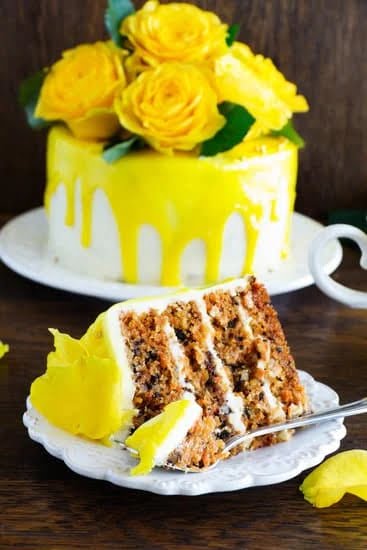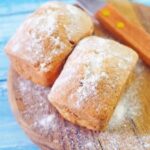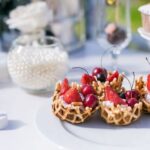Chocolate decorations for cakes are not only a delicious addition but also a visually stunning art form. From intricate patterns and sculptures to showstopping garnishes, chocolate can elevate any cake to the next level. This article explores the world of chocolate decorations, from their historical roots to the essential tools and techniques needed for creating beautiful designs.
For centuries, chocolate has been used as a decorative element in various cultures around the world. The ancient Aztecs, for instance, believed that chocolate was a gift from the gods and used it to create elaborate sculptures and decorations. Today, professional confectionery artists continue this tradition, crafting breathtaking masterpieces out of chocolate.
Understanding the different types of chocolate is crucial when it comes to cake decorations. Dark, milk, and white chocolate each have their unique flavors and properties that can be manipulated to create specific effects. By understanding how these chocolates interact with heat and other ingredients, decorators can achieve their desired results.
Creating perfect chocolate decorations requires practice and the right tools. From piping bags and molds to temperature control devices like thermometers or tempering machines, having the proper equipment is essential. Techniques such as tempering-controlling the temperature of melted chocolate-are crucial for achieving shiny finishes and stable structures.
Whether you’re a beginner looking to start simple or an experienced decorator wanting to push your skills further, there are options for everyone. This article will guide you through step-by-step instructions for creating beautiful DIY designs while also exploring advanced techniques that allow you to create intricate patterns and sculptures.
With chocolate garnishes like edible flowers or ribbons, you can add flair and elegance to your cakes effortlessly. The possibilities are endless when it comes to using these additions creatively. Whether you want a seasonal theme or something festive or themed for an occasion, there are plenty of ways to unleash your creativity.
Finally, knowing how to store and preserve your delicate chocolate decorations is essential for maintaining their freshness and integrity. Expert tips and tricks will help you keep your edible artwork looking as beautiful as the day you made it.
History of Chocolate Decorations
The history of chocolate decorations spans centuries, with its origins dating back to the ancient Aztecs. The Aztecs were known for their love of cocoa, and they developed intricate designs using chocolate on various foods, including cakes. These early decorations were more than just aesthetic enhancements; they also held cultural and religious significance.
When European explorers brought cocoa back to Europe, the art of chocolate decoration began to evolve. During the Baroque period in Europe, chocolate was considered a luxury item and was often used to create decorative details on cakes for royalty and nobility. As time went on, advancements in confectionery techniques allowed for more elaborate and intricate chocolate decorations.
Today, chocolate decorations have become an integral part of cake design and are admired for their beauty and craftsmanship. From delicate filigree patterns to whimsical sculptures, modern confectioners have elevated the art form to new heights. With the availability of different types of chocolate and innovative tools, bakers can create stunning masterpieces that rival those seen in professional pastry shops.
To create these works of edible art, various types of chocolate are used depending on the desired effect. Dark chocolate offers a rich and intense flavor but requires careful tempering to achieve a smooth finish. Milk chocolate lends a sweeter taste while still providing a smooth texture that is easy to work with. White chocolate is often used for its creamy appearance but has unique challenges due to its higher fat content.
Types of Chocolate Used in Cake Decorations
Dark, milk, and white chocolate are all commonly used in cake decorations, but each type has its own unique characteristics and uses. Understanding the differences between these chocolates can help you choose the right one for your specific cake decorating needs.
Dark chocolate is made with a higher percentage of cocoa solids and less sugar compared to milk and white chocolate. It has a rich, intense flavor and a slightly bitter taste. Dark chocolate is often preferred for more sophisticated or adult-oriented desserts because of its complex flavor profile.
Milk chocolate is sweeter and creamier than dark chocolate due to the addition of milk powder or condensed milk. It has a milder flavor that appeals to many people, making it the go-to choice for most everyday desserts. Milk chocolate also melts easily and sets quickly, making it ideal for creating molded shapes or drizzling over cake surfaces.
White chocolate contains no cocoa solids but is made from cocoa butter, sugar, and milk solids. It has a sweet, vanilla-like flavor with a creamy texture. White chocolate can be melted down and piped into intricate designs or used to create delicate accents on cakes.
While dark chocolate provides depth of flavor, and milk chocolate offers sweetness, white chocolate adds elegance to cake decorations. Many decorators prefer using a combination of these chocolates to achieve balance in both taste and visual appeal.
| Type | Flavor | Texture | Uses |
|---|---|---|---|
| Dark Chocolate | Rich, intense, slightly bitter | Firm, melts smoothly | Suitable for sophisticated desserts, piping intricate designs |
| Milk Chocolate | Sweet, creamy | Smooth, melts easily and sets quickly | Commonly used for everyday desserts, molding shapes |
| White Chocolate | Sweet, vanilla-like | Creamy, melts smoothly | Ideal for adding elegance to decorations, creating delicate accents |
When selecting chocolate for cake decorations, it’s important to choose a high-quality brand that has a good balance of flavors and the appropriate cocoa content for the desired outcome. Experimenting with different types of chocolate can open up a world of possibilities in terms of taste and visual impact.
Essential Tools and Techniques for Perfect Chocolate Decorations
The art of creating perfect chocolate decorations for cakes requires the right tools and techniques. Whether you are a beginner or an experienced baker, having the essential tools and knowing the right techniques can make a significant difference in the outcome of your chocolate decorations. In this section, we will discuss everything you need to know about the tools and techniques that are essential for creating perfect chocolate decorations.
One of the most important tools for working with chocolate is a double boiler or a microwave. A double boiler helps in melting the chocolate gently and evenly without burning it. If you don’t have a double boiler, you can also use a heatproof bowl placed over a saucepan with simmering water. For those who prefer using the microwave, it is essential to melt the chocolate in short intervals at low power to prevent overheating.
Another crucial tool for working with melted chocolate is a piping bag fitted with different sizes of tips. Piping bags allow you to create intricate designs and shapes on your cake. It is advisable to use plastic disposable piping bags for convenience, as they can be easily disposed of after use without any mess.
Aside from piping bags, silicone molds are also useful for creating various chocolate shapes and designs. These molds come in different sizes and shapes, such as hearts, flowers, stars, or even cartoon characters. They provide an easy way to create consistent and professional-looking chocolate decorations.
In addition to these tools, there are several techniques that can help you achieve perfect chocolate decorations. One key technique is tempering the chocolate, which involves heating and cooling it in specific temperatures to stabilize the cocoa butter crystals. Tempering gives the chocolate a shiny appearance and makes it less prone to melting at room temperature.
Another important technique is called “piping” which involves filling a piping bag with melted chocolate and squeezing it out through a tip onto wax paper or parchment paper in desired shapes or patterns. This technique allows you to create delicate filigree patterns, lacy designs or even write messages on your cake.
Overall, having the right tools and knowing the essential techniques can greatly enhance your chocolate decorations. Whether you are a novice or a pro, investing in high-quality tools and practicing different techniques can help you create stunning and professional-looking chocolate decorations for your cakes.
Simple DIY Chocolate Decorations for Beginners
Creating your own chocolate decorations for cakes can seem daunting, but with a few simple techniques and a little practice, you’ll be able to create beautiful designs that will impress your family and friends. In this section, we will provide step-by-step instructions for beginners to help you get started on your journey into the world of chocolate decoration.
Choosing the Right Chocolate
To begin, it’s important to choose the right type of chocolate for your decorations. Dark, milk, and white chocolate can all be used, depending on the desired flavor and appearance. Dark chocolate is generally preferred for its rich taste and ability to hold its shape well. Milk chocolate provides a sweeter flavor profile and is great for decorative drips or drizzles. White chocolate is perfect for delicate details and adds an elegant touch to any design.
Melting Chocolate Properly
The next step is melting the chocolate properly. To do this, chop the chocolate into small pieces to ensure even melting. Using a microwave-safe bowl or a double boiler, gently melt the chocolate over low heat or in short bursts in the microwave. Stir frequently to avoid scorching or burning. Be sure not to overheat the chocolate as this can cause it to seize up or become grainy.
Piping Techniques
One of the simplest ways to create beautiful designs with melted chocolate is through piping techniques. Fill a piping bag fitted with a small round tip with melted chocolate and gently squeeze out thin lines or shapes onto parchment paper or a silicone mat. Allow them to cool completely before carefully removing them from the surface using an offset spatula or your hands.
Making Basic Shapes
Another beginner-friendly technique is making basic shapes with melted chocolate. Fill silicone molds or plastic squeeze bottles with melted chocolate and gently pour into desired shapes such as hearts, stars, or flowers. Once cooled and hardened, these shapes can easily be placed on top of your cake, adding a touch of elegance and flair.
By following these step-by-step instructions, even beginners can create stunning chocolate decorations for cakes. Practice makes perfect, so don’t be afraid to experiment with different techniques and designs. With time and patience, you’ll be able to create intricate chocolate decorations that will elevate your cakes to a whole new level.
Advanced Chocolate Decoration Techniques
One of the most exciting aspects of working with chocolate decorations for cakes is the opportunity to take your creations to a whole new level with advanced techniques. By incorporating intricate patterns and sculptures, you can truly elevate the visual appeal of your cake and create a showstopper that will impress everyone.
Sugar Lace Decorations
Sugar lace decorations are a delicate and intricate way to add elegance to any cake. This technique involves creating edible lace patterns using sugar-based lace mixtures. The final result is fragile yet stunning, giving your cake a touch of sophistication.
To make sugar lace decorations, you will need a silicone lace mat and a mixture made from confectioners’ sugar, water, and gum arabic. Simply spread the mixture onto the mat, let it dry completely, and carefully peel off the lace pattern.
Chocolate Collar Wraps
If you want to add a touch of luxury and refinement to your cake, consider using chocolate collar wraps. These decorative bands made from tempered chocolate can be wrapped around the sides of your cake or used as borders between layers. To create chocolate collar wraps, you will need high-quality tempered chocolate and acetate strips or parchment paper for support.
Melt the chocolate, spread it onto the strips or paper in even thin layers, and allow them to set until firm but still pliable. Then gently wrap them around your cake and refrigerate until they harden completely.
Chocolatier Sculptures
For those who have mastered the art of working with chocolate, creating sculptural pieces can take your cake decorations to awe-inspiring heights. Chocolatier sculptures involve shaping melted chocolate into intricate shapes or realistic figures that are then used as focal points on top of cakes. This technique requires skillful tempering to achieve smooth and workable consistency with the chocolate.
You will also need specific tools such as molds, piping bags, and sculpting tools. With practice and expertise, you can create edible sculptures that will amaze your guests and make your cake a true work of art.
By exploring these advanced chocolate decoration techniques, you can truly take your cake decorating skills to the next level. Sugar lace decorations, chocolate collar wraps, and chocolatier sculptures offer endless possibilities for creating unique and visually stunning cakes that are sure to impress any audience. So why not unleash your creativity and try incorporating these intricate patterns and sculptures into your next cake design? The results are bound to be breathtaking.
Showstopping Chocolate Garnishes
When it comes to creating stunning chocolate decorations for cakes, adding showstopping garnishes can take your designs to a whole new level. Edible flowers, ribbons, and other embellishments can add flair and elegance to your cakes, making them truly memorable. Here are some ideas and techniques to inspire you:
- Edible Flowers: Using edible flowers as cake decorations not only adds a beautiful touch but also introduces unique flavors and aromas. Some popular edible flower options include violets, lavender, rose petals, and marigolds. Before using any flowers on your cake, make sure they are safe for consumption and have not been treated with any chemicals or pesticides.
- Ribbons and Bows: Another way to enhance the look of your cake is by incorporating ribbons and bows made from chocolate or edible materials like fondant or gum paste. You can create intricate designs with ribbons that wrap around the layers of the cake or form bows at the top.
- Shimmering Accents: Add a touch of glamour to your chocolate decorations by using shimmering accents like edible gold or silver leafs, lustre dusts, or metallic dragees. These elements can give your cake a luxurious appearance and make it stand out on any dessert table.
- Chocolate Transfer Sheets: Chocolate transfer sheets are a simple yet effective way of adding intricate patterns and designs to your cakes. These sheets come in various patterns including floral prints, abstract shapes, or even customized designs. Simply melt chocolate onto the transfer sheet, let it set slightly, then press it onto the surface of your cake for instant decoration.
- Chocolate Curls and Shavings: Creating curls and shavings from tempered chocolate is a classic technique that adds texture and dimension to your cake decorations. Use a vegetable peeler or a specialized tool called a chocolate curler to create delicate curls or use a grater for coarse shavings.
Remember, when using these showstopping garnishes, it’s important to consider the overall design of your cake and ensure that the flavors and styles are complementary. Experiment with different combinations of garnishes to find the perfect balance and create a stunning centerpiece for any occasion. With these techniques, you’ll be able to add flair and elegance to your cakes through the artistry of chocolate decorations.
Chocolate Decorations Inspired by Different Themes
One of the most exciting aspects of chocolate decorations for cakes is the ability to unleash your creativity and incorporate different themes into your designs. Whether you are celebrating a holiday, special occasion, or simply want to add a unique touch to your cake, themed chocolate decorations can elevate your dessert from ordinary to extraordinary.
Seasonal themes are a popular choice when it comes to chocolate decorations. For example, during the winter holidays, you can create delicate snowflakes or festive reindeer using white or dark chocolate. In the springtime, you can adorn your cake with pastel-colored butterflies made from milk chocolate. The possibilities are endless. By incorporating seasonal elements into your chocolate decorations, you not only enhance the visual appeal but also set the mood for your celebration.
Additionally, themed cake designs provide an opportunity to showcase your personal style and interests. If you’re hosting a child’s birthday party with a pirate theme, for instance, you can use chocolate decorations shaped like treasure chests or pirate ships.
For a beach-themed wedding cake, seashells and starfish made from white chocolate will add an elegant touch. You can even create custom edible images using dark chocolate transfers to make your favorite fictional characters come alive on top of your cake.
No matter what theme you choose for your cake, it’s important to plan ahead and gather all the necessary materials before starting on your chocolate decorations. Having specific molds or stencils that match your theme will make the process easier and more enjoyable. Additionally, experimenting with different colors and textures of chocolate – such as adding food coloring or using colored cocoa butter – will allow you to achieve the desired effect for each design.
Remember that while creating themed chocolate decorations may require some additional effort and practice, it is undoubtedly a fun way to showcase your creativity and impress guests with delicious edible artwork. So, the next time you’re planning a special event or celebration, consider incorporating themed chocolate decorations into your cake designs to truly unleash your imagination.
Expert Tips for Storing and Preserving Chocolate Decorations
Storing and preserving chocolate decorations is essential to ensure that your edible artwork stays fresh and intact. Whether you have crafted intricate patterns or sculpted beautiful sculptures, proper storage techniques will help prolong the life of your chocolate decorations. Here are some expert tips to help you.
Firstly, it is important to store chocolate decorations in a cool and dry place. Chocolate is highly sensitive to temperature and humidity, so avoid storing them in areas with fluctuating temperatures or high moisture levels. Ideally, keep your chocolate decorations at a temperature between 60-70°F (15-21°C) and a humidity level below 50%. This will prevent the chocolate from melting or becoming too firm.
Secondly, consider using airtight containers for storing your chocolate decorations. Exposure to air can cause the chocolate to become stale and lose its flavor. Place the decorations in an airtight container and seal it properly to create a barrier against air.
Additionally, be cautious when handling the chocolate decorations as any rough movements may cause them to break or get damaged. If you need to transport your cake or store it for an extended period, it is recommended to use sturdy packaging materials such as cardboard boxes lined with parchment paper to protect the decorations from any potential damage.
Lastly, avoid placing chocolate decorations in direct sunlight or near heat sources such as ovens or stoves. Heat can cause the chocolate to melt or warp, damaging all your hard work.
By following these expert tips for storing and preserving your chocolate decorations, you can enjoy their beauty for longer periods of time and maintain the integrity of your edible artwork. So go ahead and confidently showcase your creations knowing that they will stay fresh and intact until they are ready to shine on top of your cakes.
Conclusion
In conclusion, chocolate decorations have a rich history that dates back to the ancient Aztecs and have evolved into modern confectionery masterpieces. The types of chocolate used in cake decorations, including dark, milk, and white chocolate, each play a unique role in creating the desired taste and aesthetic. With the essential tools and techniques for perfecting chocolate decorations at your disposal, you can elevate your cake designs with ease.
For beginners, there are simple DIY chocolate decorations that provide step-by-step instructions for creating beautiful designs. These beginner techniques allow anyone to add a touch of elegance to their cakes and impress their loved ones or customers. However, for those seeking to take their cake decorating skills to new heights, advanced techniques can be explored. Intricate patterns and sculptures made from chocolate can truly make a cake stand out.
Furthermore, showstopping chocolate garnishes such as edible flowers and ribbons can add flair and elegance to any cake design. By creatively incorporating these elements into your cake decorations, you can create stunning centerpieces that will leave a lasting impression on guests at any event. Additionally, themed and seasonal designs provide an opportunity to showcase your creativity and cater to specific occasions throughout the year.
Lastly, it is important to note expert tips for storing and preserving chocolate decorations. Proper storage methods will ensure that your edible artwork remains fresh and intact until it is time for consumption. By following these guidelines, you can continue enjoying the artistry of chocolate decorations long after they have been created.
Frequently Asked Questions
How to make chocolate decorations for cake?
To make chocolate decorations for a cake, you will need melted chocolate and a piping bag or small plastic squeeze bottle. First, melt the chocolate in a microwave-safe bowl or using a double boiler. Once melted, pour it into the piping bag or squeeze bottle.
Then, begin decorating by squeezing the chocolate onto parchment paper in various shapes and designs. You can create swirls, cursive letters, flowers, leaves, or any other desired pattern. Allow the chocolate decorations to cool and harden before carefully placing them on top of your cake for an elegant finishing touch.
How to make chocolate garnishes for cakes?
Creating chocolate garnishes for cakes is a simple process that starts with melted chocolate and some basic tools. Begin by melting your choice of chocolate – dark, milk, or white – following the same method as mentioned above. Next, select molds that have desirable shapes for your garnishes like curls, fans, or spirals.
Pour the melted chocolate into the molds and tap them lightly to remove air bubbles and create even surfaces. Once set, gently remove the garnishes from the molds and place them on top of your cake or desserts as desired to enhance their visual appeal.
What can I use to decorate a chocolate cake?
There are plenty of options available to decorate a chocolate cake creatively. One popular choice is to use frosting or icing in different colors and varieties such as buttercream, cream cheese frosting, ganache, or whipped cream topping. These can be piped onto the cake using various tips to create beautiful borders, rosettes, flowers, or any other intricate patterns you prefer. Additionally, you can add texture by sprinkling finely grated chocolate shavings over the frosting or using decorative sprinkles such as colored sugar crystals or edible pearls.
Fresh fruits like strawberries or raspberries can also be added for both taste and decoration purposes – they provide vibrant color contrast against the dark cocoa base. Furthermore, consider incorporating elements like edible flowers, fondant decorations shaped like bows or ribbons, or even chocolate truffles arranged artfully on the cake’s surface for a stunning presentation. The possibilities are endless, so feel free to let your creativity flow while decorating your chocolate cake.

Welcome to our cake decorating blog! My name is Destiny Flores, and I am the proud owner of a cake decorating business named Cake Karma. Our mission is to provide delicious, beautiful cakes for all occasions. We specialize in creating custom cakes that are tailored specifically to each customer’s individual needs and tastes.





